 |
The hike down begins
Mt. Kilimanjaro, Tanzania (14Mar01) |
One would think that with all the fussing and whining I did about the
sterile, packaged experience of organized trips, that the last thing I
would want to do is go on another tour. Unfortunately, however, I was not
alone in my desire to climb Mt. Kilimanjaro, Africa's highest peak.
Thousands of people each year face the frezing temperature, thin air, and
rocky slopes in order to lay claim to bagging one of the "seven summits."
Climbing Mt. Kilimanjaro is one of Africa's premier tourist activities, and
as a result, it was a total zoo.
The moment we stepped off the bus in Arusha, we were attacked by a rabid
pack of Kilimanjaro trekking safari tour operators. Times were tough in
the tourist industry in Kenya and Tanzania; the number of tourists
visiting Africa has dwindled, and low season was soon approaching.
Consequentially, there were too many companies chasing too few tourist
dollars.
It had already been a long day traveling from Nairobi across the Tanzanian
border, and neither Diana, my travel partner, nor I were in the mood for
hassle. All we wanted to do was to catch a taxi to the bus stand so we
could complete the last two hours of the journey to Moshi, the small town
at the base of Mt. Kilimanjaro where we planned to send the night.
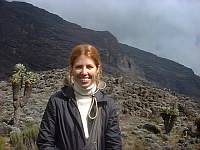 |
Diana
Mt. Kilimanjaro, Tanzania (12Mar01) |
The tour operators, however, had a different idea. Their job was to get the
fresh meat straight off the bus and straight into their offices, where they
could book a tour before their competition got their hands on us.
After beating away the worst offenders, I had hoped that we would end up
with a real taxi driver, but soon we found ourselves parked outside an
office that distinctly did not resemble a bus station. "The bus will be
here soon; let's wait in the office." The second someone mentioned a
Kilimanjaro tour to me I went ballistic. It didn't take me long to
convince them that if they valued their lives, they should take us straight
to the bus station. Five minutes later, we were on the bus to Moshi.
We weren't in the clear yet though. When I tried to pay the bus fare, the
"taxi driver" tried to wrestle the 5000 Ksh (US$8) bill from the man
collecting for the bus, and the two got into a big argument. I eventually
had to snatch the bill back, and get off the bus to find someone else to
make change.
We eventually made it to Moshi, and after a good night's sleep, we were
ready to tackle booking a tour. Moshi was a pleasant, quiet town, the kind
of place with just a couple of paved roads and a handful of small dirt
tracks lined with tailors manning footpedal driven sewing machines. Even
though it was the base for many tour agencies, we were able to wander the
streets relatively hassle free.
 |
Just like home
Moshi, Tanzania (15Mar01) |
We ended up booking with a company called M.E.M. tours. I would have
prefered to do the trip solo, but the government, realizing that they had
a lock on the Kilimanjaro climbing market, turned the mountain into a cash
cow by requiring all climbers to use registered tour agencies. Of the
US$590 for a six day trip to the summit, about US$450 went straight to the
government and most likely, straight into Benjamin Mkapa, Tanzania's president's
pocket. That left about US$140 to cover all the other expenses, including
a guide, porters, food, and equipment. That may not sound alike a lot, but
once you've factored out the government's cut, US$150 goes a long way in
Tanzania.
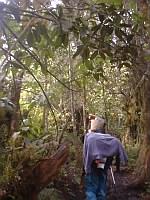 |
Hiking in the forest
Mt. Kilimanjaro, Tanzania (10Mar01) |
The name of the route we chose was called the Machame route, often referred
to as "The Whiskey Route" so that tourists don't have to struggle with
strange and difficult names like "Machame." We were joined on the climb by
Edward and Frederick, two thoroughbred upper class British chaps recently
graduated from Eton School, and out on their first adventure away from
home. Despite their stereotypical British schoolboy demeanor, they were
sweet and charming, and always impressed me with their mastery of art
history, politics, latin, and crude jokes.
Included in our entourage were our guides, Eugen and Joshua, along with
eight, that's right, eight porters. While the packing list wasn't quite as
outrageous as the Nepal trekking trip I did many years ago, on which were
carried, among other things, a full table and chairs, the pack train of
porters made our trip look more like an Everest summit bid than a routine
guided hike. I have a general rule when I travel or hike, which says that
I must carry all of my own things, because if I can't, then I have too much
and its time to jettison some things. Our guide apparently had never heard
such an outrageous idea as a client carrying their own pack, and carefully
explained to me that it was a long, difficult hike, and it would be absurd
for me to carry a full pack. After about ten minutes, he eventually
realized he wasn't going to win, and we set off up the mountain.
The first day was perhaps the most beautiful, winding through thick,
dripping green rainforest. My waterproof boots really started to prove
their worth as we sloshed through ankle deep puddles of mud. I spent most
of the first day, in fact most of each day, alternating between speaking
Spanish with Diana and speaking politics with the Eton boys. Each day the
terrain got sparser and the air thinner, and each night the simple meal of
rice, soup, and chicken seemed all the more appealing.
By the fourth night we had reached Barafu camp (4600M, 15,500ft,) our final
camp before the summit push the next day. The terrain at that point was
little more than rocks and a few hearty shrubs with giant white slab
glaciers floating above us. Even on day one, it became unbearably cold
once the sun disappeared behind the horizon, and by the time we reached
Barafu, it was downright freezing. After hurredly shoveling down our food,
we retreated to the tents to catch a few hours sleep before the summit
push.
 |
The summit
Mt. Kilimanjaro, Tanzania (14Mar01) |
March 13/14 - Summit Day. We awoke at 11:30 pm, in the dead
cold of night, to prepare ourselves to begin the ascent. The weather had
turned bad overnight, and a light snow flurry swirled through the camp.
Further down the mountain towards Moshi, lightning was cracking from a
thick, black sky. I was worried; weather is everyting when climbing
mountains, and I couldn' think of a worse place to be in a lightning storm
than on the highest point on the continent. A little voice kept playing
over and over in my head, "Head for lower ground; avoid high ground, open
spaces, and exposed ridges." I reluctantly prepared myself for calling it
a day and heading to lower ground. Our guides, however, weren't phased in
the slightest. They didn't even mention the storm, and when I asked them
if they were concerened about it, they assured me that it would stay below
the summit. Seeing as they had been on Kilimanjaro a hundred times more
than me, I yielded to their expertise. After a quick cup of tea, we donned
our headlamps and began the slow grind up.
The advantage of heading up so early was that the snowpack was frozen and
therefore much easier to ascent. The disadvantage, of course, was that it
was bone-chillingly cold, and the second we would stop for a rest, my body
would seize up. I eventually realized that it was easier for me to pace up
and down over the same 10m section while the others rested, rather than
allow myself to get cold.
 |
Ed, Fred, and the guides
Mt. Kilimanjaro, Tanzania (14Mar01) |
Fairly early on, Ed and Fred, along with their guide Joshua, started to
pull away, and Eugen stayed back with Diana and I. After more than two
hours of slow going, Diana was freezing and tired. With over four hours left
at our current pace, it was clear that she wasn't going to make it. We
decided to separate, and she stayed back with Eugen as I haeded up the
mountain in search of the others. By that point, the other group was
nothing more than a speck of light high up on the mountain. I began to run
- well, not actually run; at 5700M (18000ft.) it was more like a
slow-motion jog - up to the light above. After half an hour of full-out
exertion, I reached the other party, panting and dripping with sweat. Ed
and Fred were looking rather frazzled, and after I had a chance to catch my
breath, I continued my routine of pacing up and down to stay warm during
our various rest stops.
 |
Glaciers
Mt. Kilimanjaro, Tanzania (14Mar01) |
As we reached the rim of the crater, the solitude we had enjoyed for most
of our trip was broken as we merged with a string of hikers who had come
op the Marangu route (AKA the "Coca Cola Route.") At that point, I
decided to break away from the group and push on ahead alone. After half
an hour, I reached Uhuru Peak (5895M, 19450ft.) just as the sun peaked
above the horizon. I was the only one to make it to the top in time for
sunrise.
The summit, like all summits, was a magical place; a place of
indescribable peace and beauty. The fifteen minutes on top made the five
long days hiking up worth it. The top of Kilimanjaro is fairly flat, with
a distinct rim and shallow crater. Shortly after sunrise, Ed and Fred
arrived, and after the obligatory high fives and summit snapshots, we began
the long, painful descent.
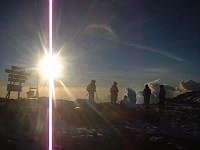 |
Sunrise
Mt. Kilimanjaro, Tanzania (14Mar01) |
For some reason beyond my understanding, the guides had decided that we
would get sick if we ate lunch. So after no more than a bowl of soup
at camp, we continued descending for another four hours. By the end of the
day I was in an incredibly foul mood. I had been hiking for 13 hours with
nothing more than a cup of tea and a bowl of soup all day, and we had run
out of water after the first nine hours. The trail was slick and rocky,
and I kept twisting my knee trying to navigate through them.
When we finally reached camp, I guzzled two litres of water, collapsed in
the tent, and passed out.
After a good night's sleep, I was in a much better mood, and we quickly
polished off the final few hours back to the base. Almost as if to
emphasize how well beaten the summit to Kilimanjaro as, the ranger station
at the base handed us certificates to show we had indeed made it to the top
of Africa: #16424/2001. I suppose it was good to see something from the
government's US$450 cut.
With Ed and Fred on their way back to England, Diana and I decided to
endure two more days as package tourists so that we could see the
magnificent Ngorongoro Crater. As we quickly learned, no matter how
packaged and mechanical an organized safari tour can be, it is far better
than a tour gone wrong.
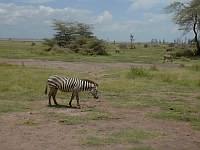 |
Zebras
Ngorongoro Crater, Tanzania (19Mar01) |
Our troubles started before we even left Moshi. Having originally decided
to join up with Ed and Fred, we found ourselves scrambling to find anyone
to go with once Ed and Fred changed plans and headed home. After idling in
MOshi for a couple of days, we finally managed to run into a few German
tourists who wanted to do a similar trip.
Things didn't start well. We had asked to start at 5am, so that would be
sure get a full first day in the crater, but the driver didn't show until
6:30. Adding in the extra half hour early that we got up because the clock
was set wrong, and that meant getting up two hours earlier than necessary.
Then, after only three hours driving, we were dropped off at a cheap hotel
hours from the crater. It seemed that the tour company decided it would be
better (read: cheaper) to put us up in a cheap hotel than pay the camping
fees for the park. Even our driver had been left in the dark, since he
had never heard anything about our plans to go to the crater that day. A
phone call to the office didn't improve my mood or the situation. They
insisted they were following our original itinerary, and that they couldn't
possibly have sold us the trip we had agreed to since they wouldn't be
able to do it for the price we paid.
Stuck in the middle, our driver did all he could to bridge the gap between
five irate customers and a swindling boss. He scrambled to find us camping
gear, which had never been loaded on the truck since they had never planned
to let us camp.
 |
The view from the rim
Ngorongoro Crater, Tanzania (20Mar01) |
Our next surprise came later in the day when, half an hour outside the
park, our driver pulled into a campsite and said, "We camp here." It
appeared that he had never been given money to pay for the more expensive
campsite, and this was the only one he could afford. A second, more
venenous call to the office had a similar result - they refused to pay for
the campsite since they insisted that they had never agreed to our staying
there. Realizing that there wasn't much we could do until we returned to
their office and could wring their necks in person, we decided it was
better to just enjoy the sights and not to get annoyed.
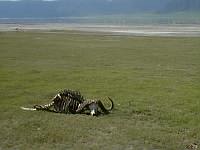 |
Death in the crater
Ngorongoro Crater, Tanzania (20Mar01) |
Driving into the crater the next morning was breathtaking. Ngorongoro
crater is actually a caldera, a giant collapsed volcano. 20 km across, it
is home to numerous elephants, giraffe, lions, buffalo, gazelle, and
countless species of birds. Since the walls of the crater are quite steep,
many of the animals just stay in the crater; a petri-dish of big game.
 |
Vulture feeding frenzy
Ngorongoro Crater, Tanzania (20Mar01) |
While seeing big game was old hat by that point, the abundance of birds and
the spectacular setting made the trip well worth all the grief we endured
gettting there. I will never forget the image of a score of vultures
buried neck deep in the carcass of a buffalo, picking at its eyes and
tearing at its dried, jerky-like flesh.
Once back in Moshi, we headed back to the office of our tour company to
unload all our pent up anger. It still didn't get us anywhere, but as the
designated aggressor, I had a very cathartic time laying into them. If you
are ever in Moshi, Tanzania, I recommend giving Kilimanjaro Travel Services
a miss.

